Travel
discover angkor temples: ancient wonders & visitor guide
The key takeaway: Strategic pass use and timed sunrise/sunset visits—like Angkor Wat’s spectacle—unlock deeper insights into Angkor’s cultural evolution and architectural feats, such as 8 km of bas-reliefs. Spanning 400 km², balancing logistics with cultural respect (dress codes, preservation) ensures a meaningful exploration of this 9th-15th century Khmer marvel.
Feeling overwhelmed by the vastness of Angkor Temples? Our angkor temples guide cuts through the chaos, offering a curated roadmap to navigate this UNESCO-listed wonder. Whether you’re marveling at sunrise reflections at Angkor Wat, unraveling the spiritual stories behind Bayon’s iconic faces, or stepping into the jungle-embraced ruins of Ta Prohm, this guide ensures you won’t miss the highlights. We’ll help you plan your visit with tips on passes, transport options like tuk-tuks and bikes, and hidden gems like Banteay Srei. From decoding ancient bas-reliefs to mastering temple etiquette, prepare for a journey through Cambodia’s legendary Khmer Empire that’s as smooth as it is spellbinding – no prior expertise required.
- Your essential introduction to the temples of Angkor
- Planning your visit: tickets, timing, and transport
- The Heart Of The Empire: Must-See Temples
- Exploring beyond the main circuit
- Crafting Your Perfect Angkor Itinerary
- To guide or not to guide: making the right choice
- Tips for a respectful and memorable visit
Your essential introduction to the temples of Angkor
Step into a world where ancient stone whispers tales of divine legends and architectural mastery. The temples of Angkor stand as a UNESCO World Heritage Site, spanning from the 9th to 15th centuries as the heart of the Khmer Empire. These structures were not just places of worship—they were the epicenter of a civilization that shaped Southeast Asia’s cultural landscape for centuries.
At their core, the temples reveal a profound religious evolution. Originally dedicated to Hindu deities like Vishnu, sites such as Angkor Wat gradually transformed into Buddhist sanctuaries. This shift is etched into every carving, where Hindu epics like the Ramayana coexist with serene Buddha statues. The Bayon Temple exemplifies this duality, blending intricate depictions of Hindu cosmology with the compassionate visages of Avalokiteshvara.
What sets Angkor apart? Its scale is staggering: 400 square kilometers of temples, reservoirs, and urban networks. The concentric gallery design of Angkor Wat, symbolizing Mount Meru’s sacred peaks, showcases engineering genius. Equally mesmerizing are the bas-reliefs—over 1,000 meters of mythological battles and celestial dancers (apsaras) that narrate humanity’s eternal dance between chaos and order.
Visitors today face a choice: will they miss the sunrise hues over Angkor Wat’s central towers? Or overlook the etiquette of modest attire required to enter sacred spaces? This guide ensures you’ll navigate these wonders with clarity, from unraveling the symbolism of Garuda’s wings to securing the right ticket for multi-day explorations. Let’s begin this journey through stone and spirit.
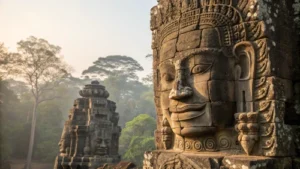
Angkor Wat temples

Angkor Wat temples
Planning your visit: tickets, timing, and transport
Understanding the Angkor pass
The Angkor Archaeological Park requires an official Angkor Pass for entry. Three options exist: $37 for 1 day, $62 for 3 days (valid over 10 days), and $72 for 7 days (valid over 30 days). Each pass includes a $2 donation to Kantha Bopha Children’s Hospital. Passes are non-refundable, non-transferable, and require a photo taken at purchase. Buy tickets exclusively at the official ticket center on Street 60, Krong Siem Reap, open daily from 4:30 AM to 5:30 PM, or purchase online via the official platform. Avoid unauthorized sellers to prevent scams.
Children under 12 enter free with ID (e.g., passport). Passes grant access to most temples, including Banteay Srei and Beng Mealea, but exclude Phnom Kulen ($25) and Koh Ker ($10). Lost passes incur penalties: $100 for 1-day, $200 for 3-day, and $300 for 7-day passes. Payment options include cash (USD, EUR, THB, KHR) or card (Visa, Mastercard, UnionPay, etc.). ATMs are available on-site. Note that 1-day passes bought after 5 PM are valid for the following day and include free sunset access the same evening.
Best time to visit
Visit during November to March for dry, pleasant weather, though peak crowds gather at sunrise. For fewer visitors, consider the rainy season (June to October), which offers lush landscapes despite sporadic showers. Temple hours generally run 7:30 AM–5:30 PM, except Angkor Wat (5 AM–5:30 PM) and Phnom Bakheng (5 AM–7 PM), ideal for sunrise or sunset views.
Arrive early to avoid midday heat and crowds. Angkor Wat’s sunrise is iconic, while Pre Rup and Phnom Bakheng host stunning sunsets. Plan visits to popular sites during off-peak hours for a serene experience. Dress appropriately: cover shoulders and knees when purchasing tickets and entering temples. Lightweight clothing, hats, and water are recommended year-round.
Getting around the archaeological park
| Transport Option | Best for | Pros | Cons |
|---|---|---|---|
| Tuk-tuk | Flexibility and local guidance | Easy to find, driver acts as basic guide, shade from sun | Price negotiation required, slower speed |
| Bicycle | Budget travelers and active visitors | Affordable, eco-friendly, full independence | Physically demanding, slow for long distances |
| E-bike / Scooter | Independent exploration | Faster than cycling, quiet, extended range | Requires driving confidence, battery life limits |
| Private car with driver | Comfort and groups | AC, fast, family/group-friendly | Most expensive option |
The park spans 400 km², making walking impractical. Tuk-tuks are popular for their convenience, while bicycles suit budget travelers seeking an adventurous pace. E-bikes balance speed and independence, ideal for covering 2–3 temples daily. Private cars offer comfort but at a higher cost. Renting a vehicle in Siem Reap is recommended, with pre-negotiated prices to avoid overpaying. Motorbikes are permitted in the park but require a valid license and prior experience navigating uneven roads. For sunrise at Angkor Wat, book a tuk-tuk the night before to ensure early departure.
The Heart Of The Empire: Must-See Temples
Angkor Wat: Masterpiece Of Khmer Architecture
Angkor Wat dominates the Cambodian skyline as the world’s largest religious structure, spanning 162.6 hectares. Built in the 12th century by King Suryavarman II, this Hindu-turned-Buddhist temple symbolizes the transition of Khmer spirituality. Its westward orientation—unusual for Hindu temples—aligns with its role as a funerary monument, possibly for the king himself.
The temple’s concentric galleries lead visitors through a cosmic journey mirroring Mount Meru, the sacred Hindu mountain. The outer gallery’s 800+ meters of bas-reliefs depict epic tales like the Churning of the Ocean of Milk, where gods and demons churn for immortality, and Krishna’s Victory over Banasura, emphasizing Vishnu’s supremacy. These carvings blend artistry with historical narratives, including scenes of Suryavarman II’s royal procession, showcasing his divine authority.
Arrive at 5:30 AM to witness the sunrise, where the temple’s central towers reflect perfectly in the rectangular moats. A $37 one-day pass grants access to Angkor Wat, Angkor Thom, and nearby temples. Dress code requires covering shoulders and knees—scarves are available at the entrance. Avoid climbing unstable structures to preserve the site’s integrity
Angkor Thom: The Great Walled City
Enclosed by 8-meter-high walls and moats, Angkor Thom was the Khmer Empire’s last capital, founded by King Jayavarman VII in the late 12th century. Its five gates, each flanked by 54 stone figures pulling a serpent, symbolize the churning ocean myth. The Bayon Temple at its heart houses 216 massive stone faces, their serene smiles altering perceptions of space and time.
Bayon’s faces—partially restored—merge Buddhist compassion with royal authority. The temple’s bas-reliefs shift from Hindu epics to historical scenes, like naval battles and processions, offering rare glimpses into Khmer military and daily life. Nearby, the Baphuon’s 34-meter pyramid stands as an early example of sandstone engineering, while the Elephant Terrace’s carvings of elephants and royal hunts once hosted grand ceremonies.
Visit between 7:30 AM and 5:30 PM to avoid midday heat. Allocate 3–4 hours to explore the city. The $72 three-day pass includes sunrise access to Phnom Bakheng Hill, offering panoramic views of Angkor Thom at dusk. Stay alert for opportunistic monkeys near the Leper King Terrace, a puzzling site with cryptic statues and inscriptions.
Ta Prohm: Where Nature Reclaims History
Ta Prohm’s haunting beauty lies in its symbiosis of architecture and nature. Constructed in 1186 as a Buddhist monastery, it housed 12,500 residents and treasures worth a small fortune. Today, 500-year-old silk-cotton and strangler fig roots strangle stone galleries, creating a labyrinth of crumbling arches and shadowy corridors.
The temple’s most iconic scenes include the “Tomb Raider Tree,” where roots grip a tower like skeletal fingers, and hidden devata carvings nestled in crevices. Unlike other temples, Ta Prohm’s ruins remain unrestored in sections, preserving its raw allure. The Archaeological Survey of India stabilizes vulnerable areas with wooden walkways, ensuring visitor safety without compromising authenticity.
Plan for 1.5–2 hours to navigate the temple’s maze. The Great Departure relief, showing Siddhartha’s exit from palace life, contrasts with the “Dinosaur of Ta Prohm”—a carvings resembling a stegosaurus, sparking pseudoscientific debates. Avoid touching moss-covered stones; the site’s fragility requires strict visitor etiquette. As dusk falls, the temple’s jungle soundtrack—bird calls and rustling leaves—completes the immersive experience.
Exploring beyond the main circuit
Banteay Srei: the citadel of women
Banteay Srei stands apart from Angkor’s grand temples. Built in 967 CE by Brahmin nobles Yajnavaraha and Vishnukumara, not kings, it surprises with miniature scale and pink sandstone. The stone’s hardness preserved intricate carvings of Hindu epics like the Ramayana—scenes so detailed they inspired legends about female artisans. Restoration efforts by Suryavarman II’s guru in 1011 CE blended original artistry with later modifications, ensuring its remarkable preservation.
Three concentric enclosures house 200 devatas and a 9-meter central tower. Tridimensional carvings of mythical beasts and celestial dancers contrast with flatter reliefs elsewhere in Angkor, earning its “Citadel of Women” moniker. Archaeological findings, including 1304 inscriptions, suggest its role as a spiritual retreat, offering insights into medieval Cambodian religious practices.
Preah Khan: the temple of the sacred sword
Preah Khan offers a quieter counterpart to Ta Prohm. Constructed in 1191 CE by Jayavarman VII, it honored his father with a 56-hectare complex blending temple, city, and Buddhist university. Over 100,000 staff once maintained this site, including 1,000 dancers and teachers, making it a hub of daily life before its decline post-15th century.
Unique features include a rare two-story building with round columns—possibly a granary—and causeways decorated with devas and nagas. Its blend of Buddhist and Hindu elements, plus ongoing conservation by the World Monuments Fund since 1991, makes it a living archaeological site. The northern Shiva sanctuary and southern royal dedications highlight Jayavarman VII’s syncretic vision, while biofilm damage from algae and fungi adds conservation urgency.
Other notable temples worth a detour
For travelers with extra time, these sites deliver distinct experiences:
- Pre Rup: This 10th-century brick temple offers sunset views over rice fields. Rated 4.3/5 on TripAdvisor, its five towers and laterite construction create dramatic silhouettes against Angkor’s skyline. Arrive early to capture golden-hour photos without crowds.
- Ta Som: Once framed by a strangler fig tree (removed in the 2010s for preservation), this 12th-century temple retains atmospheric overgrowth. Rated 4.4/5 on TripAdvisor, its serene cloisters reward quiet exploration, especially during midday lulls at main sites.
- Neak Pean: This “Entwined Serpents” temple features five interconnected pools symbolizing sacred Himalayan waters. Central naga statues and astrological pool systems reflect Jayavarman VII’s focus on spiritual medicine, with seasonal water levels affecting its therapeutic symbolism.
Each temple provides unique photo opportunities and historical insights while avoiding Angkor Wat’s crowds. For a 2-3 day itinerary, pair Preah Khan with Ta Prohm’s morning visit, saving Banteay Srei for late afternoon light. Purchase 3-day passes ($40) for flexible exploration, and dress modestly—covering shoulders and knees—to respect cultural norms.
Crafting Your Perfect Angkor Itinerary
The One-Day Express Tour: The Small Circuit
Visiting Angkor’s Small Circuit in one day demands speed and focus. Start before dawn at Angkor Wat, where sunrise reflections in its moats create iconic photo opportunities. Explore its galleries and towers while crowds disperse. Marvel at 800-meter bas-reliefs depicting Hindu epics—the Mahabharata and Ramayana unfold through intricate carvings.
Head to Angkor Thom via the South Gate. Prioritize Bayon Temple’s serene stone faces and the Baphuon’s dramatic central tower. End at Ta Prohm, where jungle-clad ruins evoke ancient mystery. Over 2.6 million annual visitors confirm these highlights—don’t miss Preah Paliley, a hidden gem near Bayon with exquisite stonework.
The Two-Day Discovery: Small And Grand Circuits
Splitting your visit across two days avoids rush and fatigue. Day one: Explore the Small Circuit’s iconic sites at a relaxed pace. Begin with Angkor Wat’s concentric galleries, symbolizing Mount Meru. Afternoon: Dive into Angkor Thom’s historical depth, like the Elephant Terrace’s carvings.
Day two: Tackle the Grand Circuit’s lesser-known gems. Start with Preah Khan’s labyrinthine corridors, once a major site. Follow with Neak Pean’s healing pools, representing sacred Himalayan lakes. Conclude with a sunset at Pre Rup, a quieter alternative to Phnom Bakheng. This balance ensures you see 80% of must-see temples without overwhelming schedules.
The Three-Day Immersive Experience
Three days allows deeper exploration. Follow this structured plan:
- Day 1: The Grand Circuit. Start with Preah Khan’s overgrown beauty. Discover Neak Pean’s symbolic pools. End at Pre Rup’s brick pyramid for sunset.
- Day 2: Sunrise And The Small Circuit. Wake at 5 AM for Angkor Wat’s sunrise. Explore its concentric galleries and the Bayon’s 216 shifting faces. Briefly explore the Leper King’s inscriptions.
- Day 3: Outer Temples And Relaxation. Visit Banteay Srei’s rose-quartz carvings—Angkor’s jewel. Cap with Roluos Group’s 9th-century temples, like Bakong’s pyramid, the empire’s birthplace.
This itinerary covers 90% of Angkor’s UNESCO sites while respecting cultural protocols like modest attire (cover shoulders/knees) and ticket costs (37–72 USD for 1–7 days). Pre-purchase tickets online to skip lines and carry water to stay hydrated under Cambodia’s sun.
To guide or not to guide: making the right choice
Choosing between a licensed guide and self-guided exploration at Angkor depends on priorities. Balance historical depth, convenience, and budget to decide what works best for your visit. With over 100 temples spread across 400 km², the decision directly impacts your ability to grasp the site’s complexity.
The benefits of hiring a licensed guide
Guides decode intricate bas-reliefs and explain religious symbolism, like Angkor Wat’s concentric galleries symbolizing Mount Meru. Their insights boost historical understanding 300% more than solo visits. They contextualize shifts from Hindu to Buddhist motifs, such as Bayon Temple’s serene faces representing compassion.
They optimize itineraries—visiting 8-10 temples privately versus 4-6 alone—and reduce crowd exposure by 90% during peak hours. Costs range from $15/person (group) to $26+/person (private), with 74% higher satisfaction rates for personalized tours. For $45-75/person, private tours include tailored themes like “hidden carvings” or “sunset photography angles.” Always confirm their official badge before booking.
Exploring Angkor independently
Self-guided tours save costs—$37/day entry—and let travelers linger at sites like Bayon Temple. Apps like “Angkor Explorer” map routes, but 70% of cultural context may be missed. Solo visits risk inefficient routing (50-60% fewer temples seen) and crowded sunrise spots. Photography suffers without expert timing tips, reducing iconic shots by 40%.
This suits budget travelers prioritizing flexibility over depth. Combining apps with pre-research on temple layouts can mitigate knowledge gaps. For example, Angkor Wat’s western orientation links to Hindu funerary practices—a detail often overlooked without guidance.
How to find a reputable guide
Check credentials via Cambodia Tourist Guide Association (CTGA) or KATGA. Over 3,000 licensed guides list profiles with language options. Always verify their badge and discuss itineraries upfront—request themes like “Hindu-Buddhist transitions” or “hidden carvings.” Private guides cost $45-75/person. Book early during peak seasons and confirm logistics expertise, like weather adaptations or ticket purchases, for stress-free exploration of Angkor’s 400 km² site. Hotels in Siem Reap often connect travelers with pre-vetted guides, while Tripadvisor’s filtered reviews highlight top-rated professionals.
Tips for a respectful and memorable visit
The Angkor code of conduct: dress and behavior
The temples of Angkor are active religious sites requiring respectful conduct. Dress appropriately: guards at Angkor Wat’s Bakan sanctuary may deny entry to those in revealing clothing. Vendors near the park sell modest attire, but preparation is better. Opt for cotton or linen fabrics to stay cool while respecting cultural norms.
- Dress code: Cover shoulders and knees. T-shirts or shirts work better than scarves. Choose breathable fabrics for comfort. Dark colors minimize visible dust, while light tones reflect heat.
- Respect the monuments: Avoid touching carvings dating to the 12th century. Even hand oils can erode them over time. Climbing or sitting on structures is strictly prohibited to prevent wear.
- Be mindful of monks: Ask permission before photographing monks. Physical contact, especially for women, disrupts monastic discipline. If greeted, a slight bow with palms together shows respect.
- Keep it quiet: Speak softly to honor the site’s sacred atmosphere and avoid interrupting rituals. Use hand signals or hushed tones when sharing discoveries with companions.
Beating the heat and avoiding “temple fatigue”
High temperatures and humidity demand preparation. Start each day hydrated—aim for 3-4 liters of water. Electrolyte supplements like Royal-D help. Wear loose, moisture-wicking clothing and a wide-brimmed hat. Avoid peak heat (12 PM–3 PM) by booking sunrise visits to Angkor Wat, where the golden light enhances stone carvings.
Use tuk-tuks to rest between temples during midday. For “temple fatigue,” alternate large sites like Bayon Temple with smaller ones like Baphuon. Schedule breaks at shaded spots like the Angkor National Museum or local cafés serving iced coconut water. A compact umbrella or cooling towel can provide quick relief.
Responsible tourism in Angkor
Your actions shape local and environmental outcomes. Avoid buying from child vendors, as it risks normalizing child labor. Support NGOs like Sisters of the Holy Spirit or Friends-International, which focus on education. Donations fund school supplies, uniforms, and vocational training for vulnerable youth.
Angkor’s conservation includes the gibbon reintroduction project. Since 2013, six gibbons, including third-generation infant Kdam in 2023, have been born. These primates aid forest regeneration through seed dispersal. The Angkor Water Resilience project also manages climate-related droughts and floods by restoring ancient reservoirs.
By following these guidelines, visitors help preserve Angkor’s cultural and ecological heritage for future generations. Ethical choices today ensure the temples remain a living treasure tomorrow.
The temples of Angkor stand as a testament to the Khmer Empire’s grandeur, blending architectural brilliance with spiritual legacy. Whether marveling at Angkor Wat’s sunrise or wandering Ta Prohm’s jungle-clad ruins, every moment here reveals centuries of history. Plan thoughtfully, respect the site’s sacredness, and let Angkor’s timeless wonder inspire a deeper connection to Cambodia’s cultural and natural heritage.

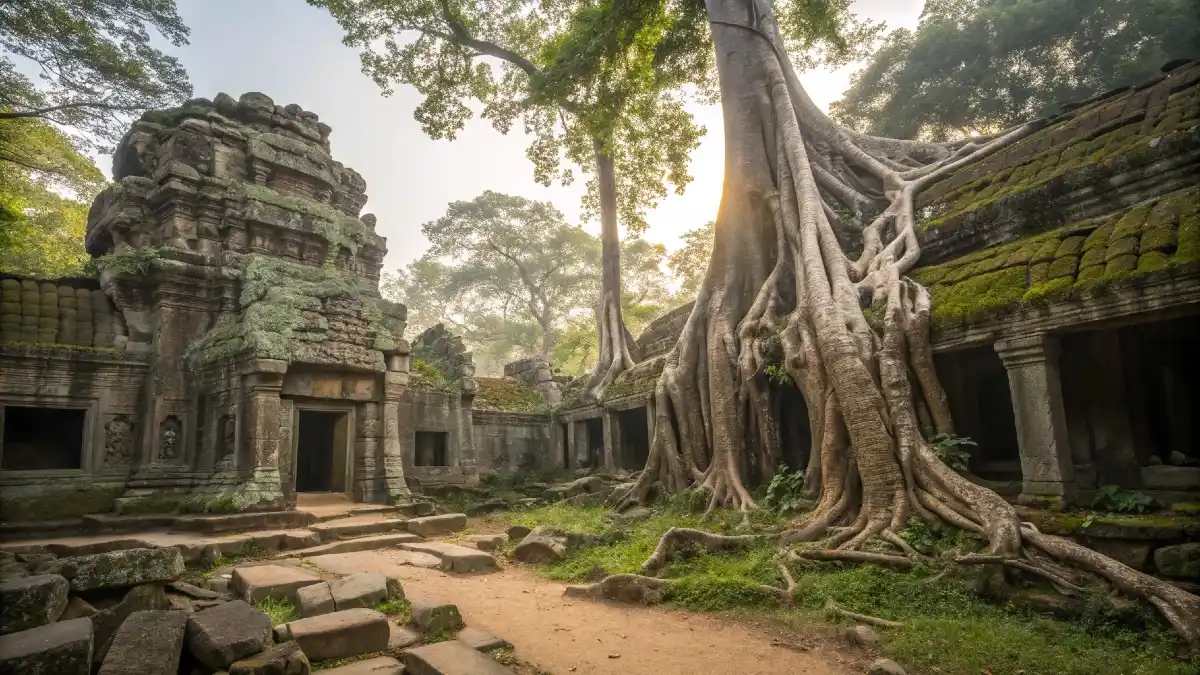
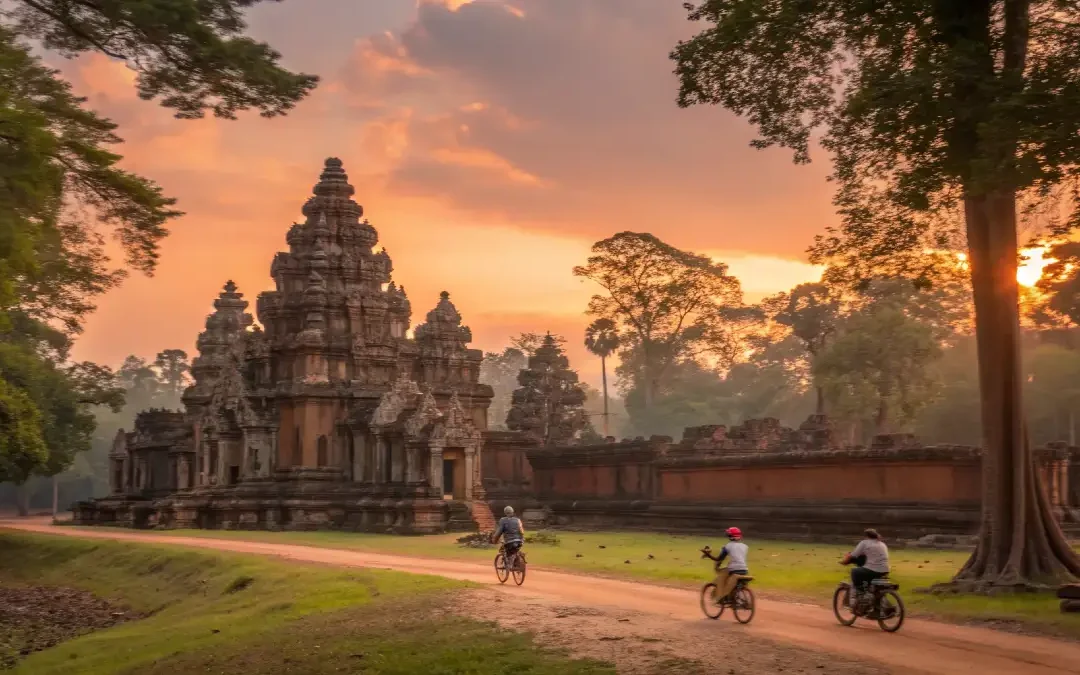
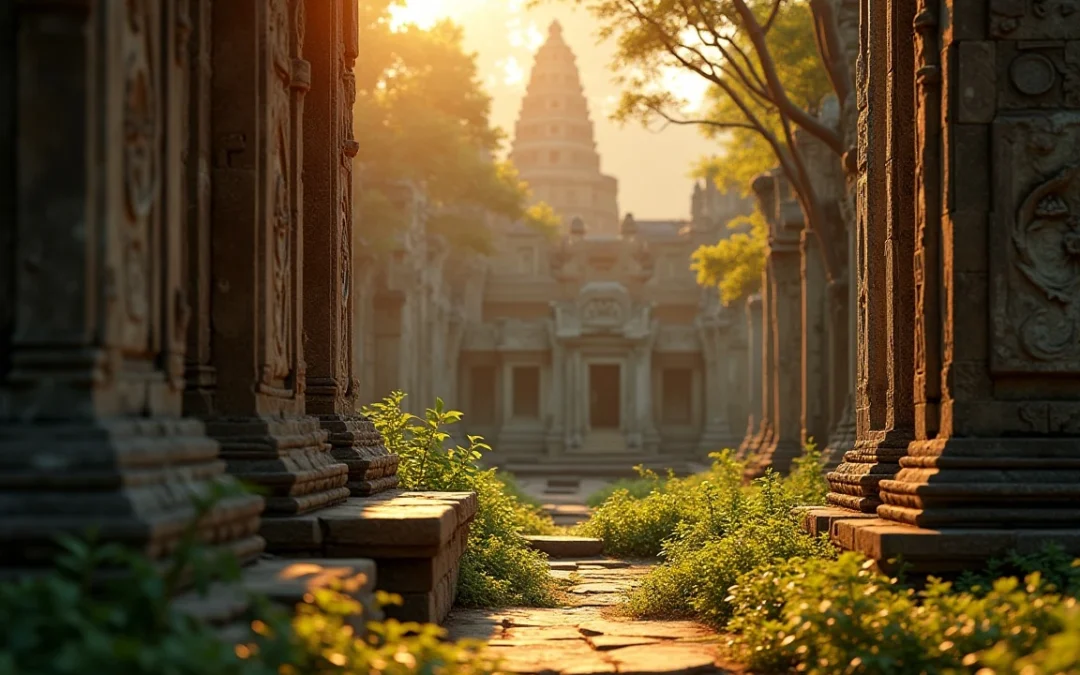
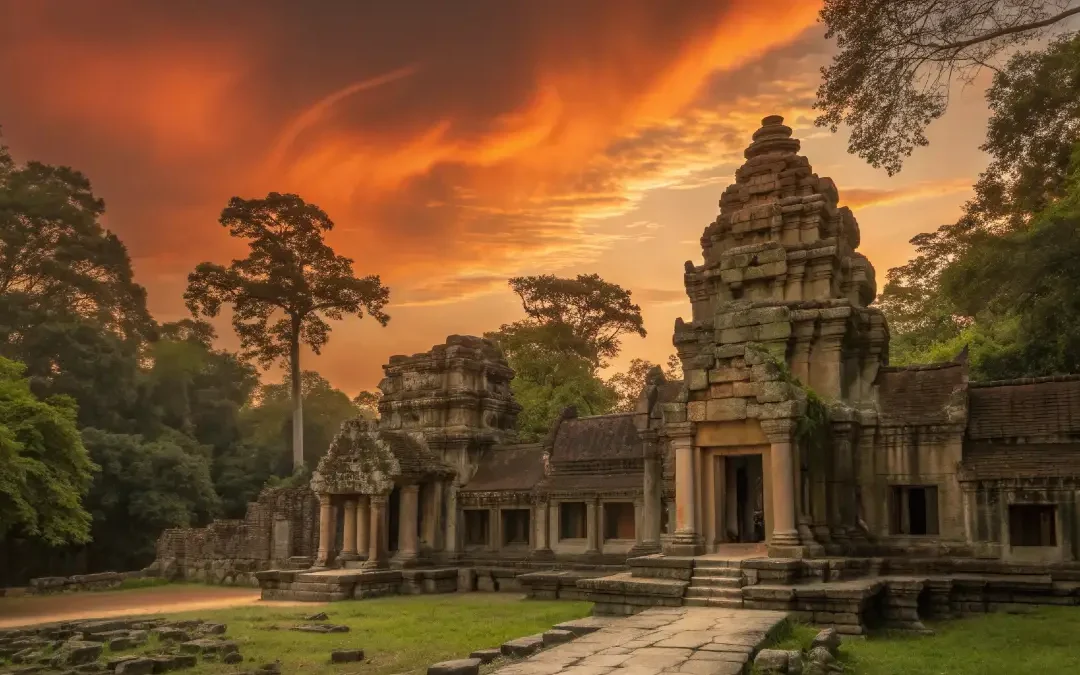
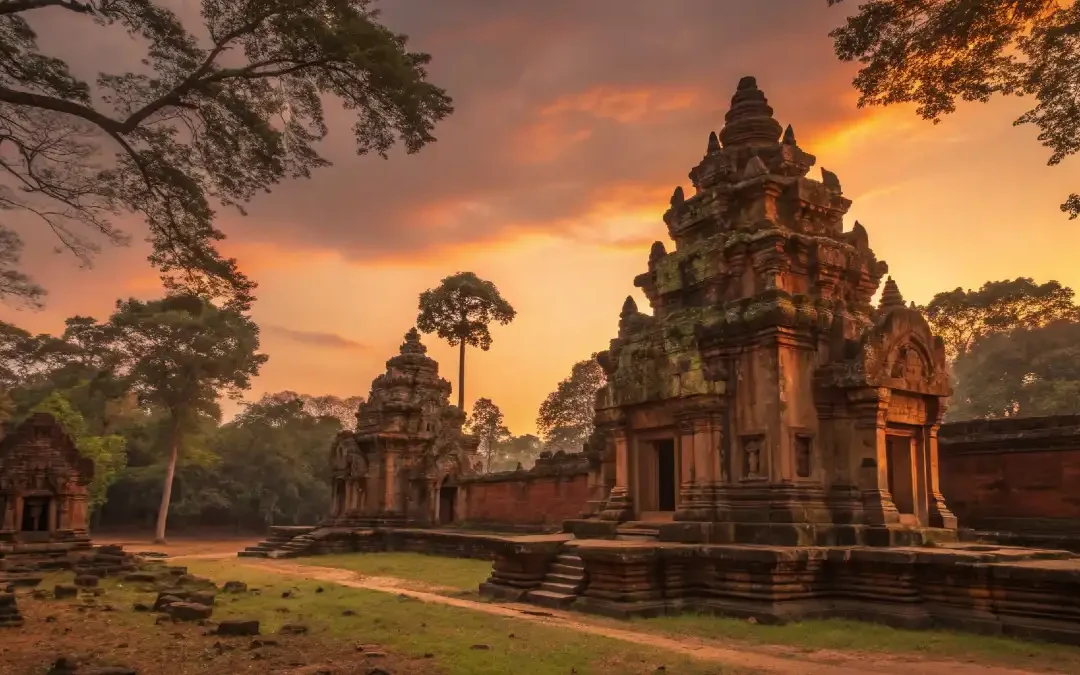
0 Comments